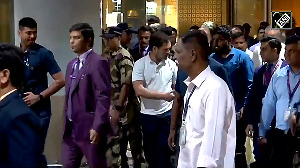The recent extraordinary growth in telecommunication connections in India, which topped 15 million per month in January 2009, has understandably grabbed the headlines. These huge numbers, however, disguise a disturbing reality which is the enormous variation within India. Many of the less developed states have state-wide average penetration rates of well below 20 per cent, including Bihar, Uttar Pradesh, Orissa, Madhya Pradesh and Assam.
More perilous, however, is the inequality between rural and urban India. Despite several policy initiatives to promote rural penetration, growth in teledensity continues to be skewed in favour of urban India. In fact, the rural population is much worse off than it was a few years ago compared to its urban counterpart.
In March 1998, the difference between urban and rural teledensity was 5.4. In September 2008, the corresponding number had grown to 56.6, which means the divide has worsened almost 12 times in the last 10 years. Since number of fixed phones is declining, the entire change can be attributed to mobile telephony.
A recent report by ICRIER on the impact of mobile phones shows there is a causal relationship between higher mobile teledensity in Indian states and higher economic growth. States with high mobile penetration can be expected to grow faster than those states with lower mobile penetration rates, and by 1.2 percentage points for every 10 per cent increase in the penetration rate.
This finding underlines the urgency of increasing teledensity across all states and especially in those numerous many areas that are yet to reach threshold levels. Indeed, the Telecom Regulatory Authority of India has also recently expressed concern over the growing disparity in two of its recent documents. One is specifically devoted to rural penetration issues and the other relates to the regulatory regime for charges that an operator needs to pay for the use of a competitor's network, the so-called interconnect usage charge regime.
Regrettably, the line of attack in the latter might well worsen rather than reduce the digital divide. At a time when the world economic crisis threatens to shrink resources available for investment, Trai's proposed interconnection regime will hurt the business cases of incumbent operators who having covered urban areas are now already deploying networks in rural areas. It will, instead, help new entrants, keen to exploit regulatory anomalies in India, to eat into the urban revenues rather than aid growth in rural areas.
Here is the argument.
Interconnection charges include payments for origination, carriage, transit and termination of calls on competing networks. Trai, which has complete jurisdiction in interconnection issues and need not involve the government in these deliberations, set the termination rate at Rs 0.30 per minute for all calls whether fixed or mobile. It leaves origination charges to operators and limits carriage and transit to Rs 0.65 and Rs 0.20 per minute.
Recent consultation held by the authority in Delhi and Hyderabad on the IUC regime, revealed an inclination to reduce the termination charges by about 50 per cent on the ground that the actual incremental costs of interconnection incurred by operators are now lower.
In this approach, an operator's capital costs are excluded from calculations of interconnection charges and are to be recovered from charges levied on its own subscribers. Many regulatory authorities around the world subscribe to this scheme since it favours new competitors, especially when they seek to take on incumbent monopolies with almost ubiquitous networks, like in developed countries.
This is just not the scenario in India where large parts -- especially rural areas -- have no connectivity at all. With a termination charge of Rs 0.30 per minute, the IUC regime in India is already amongst the most favourable to operators seeking interconnection.
The current IUC can hardly be seen as a barrier to competition in the present state of network development. It seems implausible that India's incumbent operators can recover capital costs as they did traditionally through rental charges or through call charges, already among the lowest in the world. It is worth recalling that prepaid users, that are around 80 per cent of India's total subscriber base, do not pay a recurring monthly charge or significant connection fees.
Given this situation, a further reduction in termination rates, the so-called mobile termination charge, would seriously impact mobile operator plans to expand in rural areas. Rural subscribers typically receive more calls than they make and a reduction in MTC revenue to operators will further reduce their revenue realisation and consequently their incentive to expand in rural areas. More so, if the new MTC hurts urban revenues as well.
Currently, mobile operators realise a large component of their revenue in the form of MTC for low ARPU subscribers. A lower MTC would further reduce the incentive to acquire rural subscribers. The new measures would make sense if Trai had demonstrated that operators were reluctant to expand rural networks in spite of the surplus from interconnection charges. It has not.
It is also important to debunk another argument that reducing interconnection charges will facilitate competition and thereby benefit customers. This argument seems disingenuous given that on an average existing subscribers can access seven or eight mobile operators, which is unprecedented in any mobile market in the world.
It is increasingly argued that the fragmentation of Indian telecom market has already led to inefficient utilisation of scarce spectrum. That the new entrants in India's crowded telecom market were attracted primarily by the chance of acquiring precious spectrum at bargain prices has been amply demonstrated by recent transactions in mobile licences.
If, in the name of increasing competition, Trai were to reduce the already low interconnection charges, we fear it will hurt rural users even before networks can be rolled out for them. It has been shown that access to telecommunications can help improve productivity and efficiency, and enable benefits of economic growth to be shared. The rural population, therefore, at least deserves a chance. If, say, in one year, the urban-rural disparity shows no signs of abating, Trai may well be justified in considering a tougher IUC regime to reduce the unearned profits of mobile operators.
Rajat Kathuria is professor at ICRIER (rkathuria@icrier.res.in) and Mahesh Uppal director of Com First, India (mahesh.uppal@gmail.com)







 © 2025
© 2025